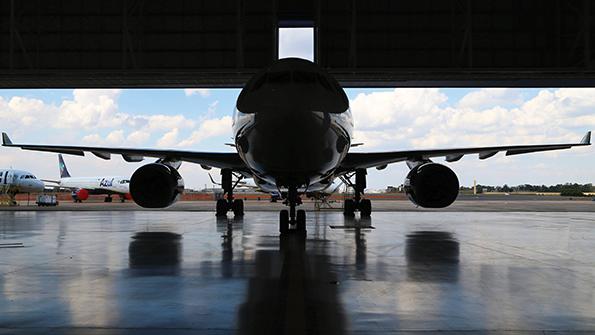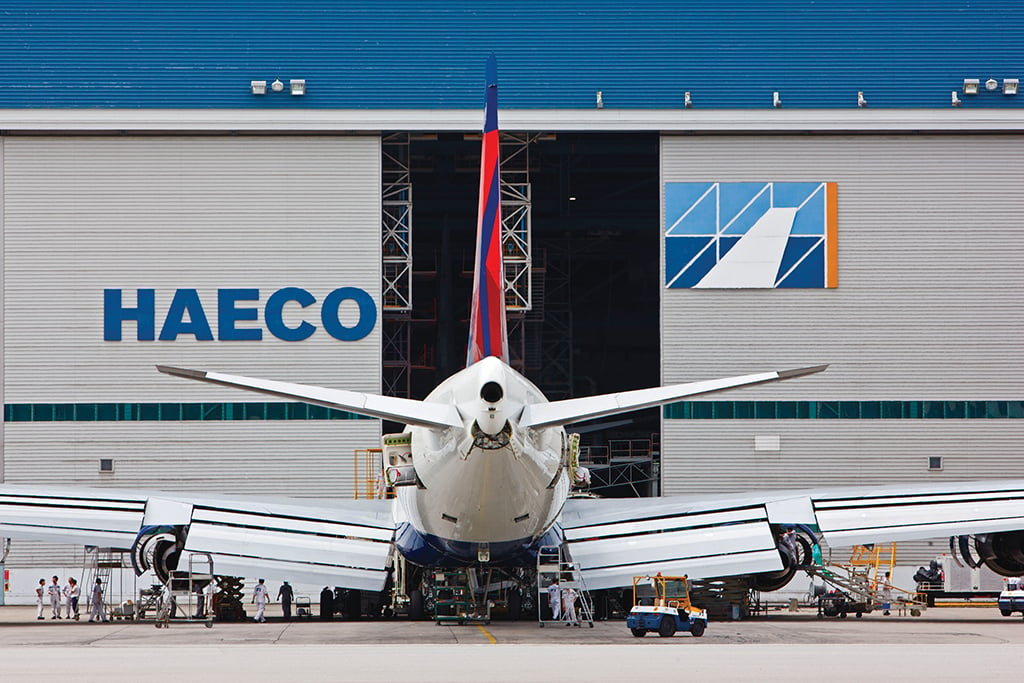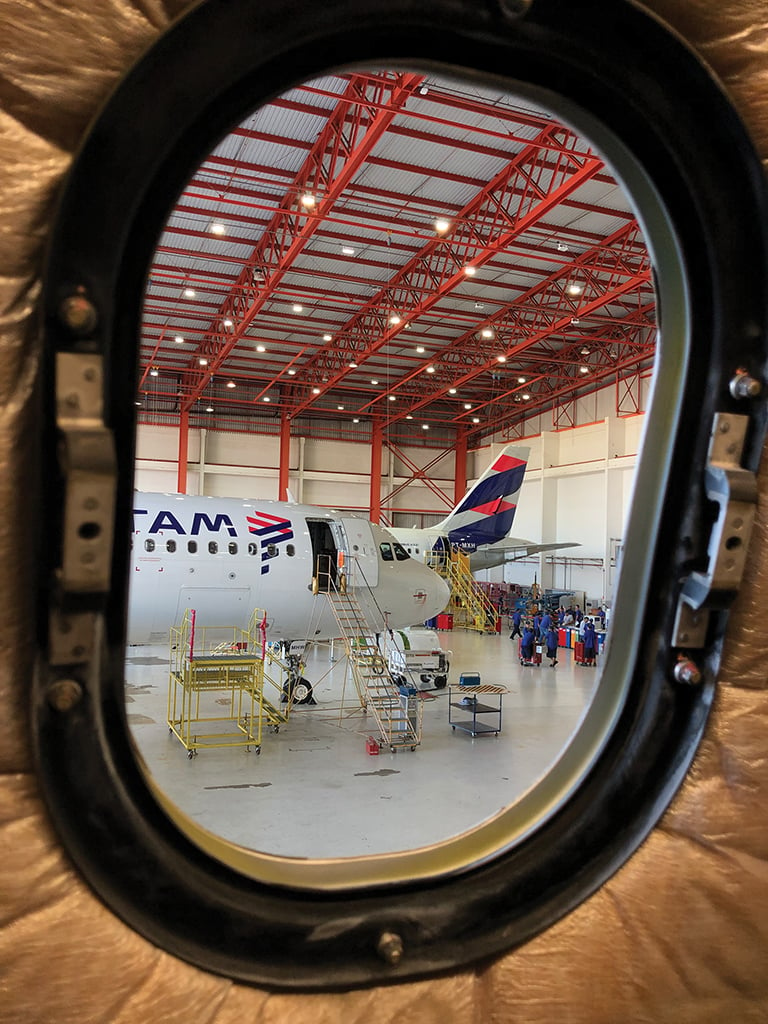This article is published in Aviation Week & Space Technology and is free to read until Jun 08, 2024. If you want to read more articles from this publication, please click the link to subscribe.

Airlines must factor in the additional downtime and costs to transport aircraft or engines to distant MRO providers.
Since the beginning of the new millennium, Western airlines have sent increasing numbers of aircraft, especially widebodies, outside their home regions for heavy maintenance, aiming to take advantage of lower labor rates in places such as Asia and Latin America.
Toward the end of the last decade, however, there were signs that this trend was slowing or even reversing. Wage differentials were narrowing between West and East, and the growing fleets of Asian carriers were putting pressure on local MRO capacity. Furthermore, globalization and offshore supply chains were coming under increasing pressure from the Trump administration, while growing environmental, social and governance concerns were causing some airlines to question the sustainability of long ferry flights to distant hangars.
Many of these factors are continuing. Sustainability remains a hot topic, and the Biden administration also champions domestic production. Offshore support may be tested by a bill—the Global Aircraft Maintenance Safety Improvement Act—that would make it harder for U.S. airlines to contract maintenance abroad.
“This is not a partisan issue,” says Pete Donohue, senior director of communications for the Transport Workers Union of America (TWU), which supports the bill. “The text of this legislation was included in its entirety in both the House and Senate FAA Reauthorization bills this year. The House passed this same bill last Congress. We expect this legislation to be final this Congress and the next administration, regardless of who the president is, to swiftly enact these measures to return aircraft maintenance jobs to the U.S.”
However, the effects of the COVID-19 pandemic also must be acknowledged. Asia-Pacific-region airlines were much slower to recover than their peers in Europe and North America, especially in the widebody market, where they had begun to contest heavy maintenance slots in the years leading up to 2020. According to the International Air Transport Association, Asian airlines’ international capacity in 2023 was still 29% below its pre-pandemic level, whereas North American airlines had surpassed it, and European airlines were just 5% lower.
Near or Far?
When choosing between local or distant maintenance provision, airlines must consider the additional downtime and costs to transport aircraft or engines to the facility. Then there is oversight, which usually requires on-site personnel responsible for quality control and ensuring that the airline’s aircraft receives the same prioritization as more local customers.
Despite these extra costs, often it still makes financial sense for Western airlines to outsource to MRO providers in regions such as Asia and Central America. When Virgin Atlantic selected Lufthansa Technik Philippines for base maintenance of its Airbus A340s in 2008, it benefited from a labor rate roughly one-fourth that at a European MRO, says Phil Seymour, president of consultancy IBA Aviation.
Such huge savings were temporary, however: Sabena Technics tells Aviation Week that the labor hours needed to cover the extra ferrying and logistics costs of European aircraft flying to Asian MRO providers doubled from 2009 to 2019.
That said, a labor rate differential persists and is large enough to make a strong economic case for shifting heavy maintenance to the East, even if airlines are loath to base their offshoring decisions on a single factor.

“Our Asian partner has succeeded well in overall performance and is well located within our flight network, which also increases overall efficiency,” says a spokesperson for Finnair, which first selected Hong Kong-based HAECO for base maintenance in 2008 and last year extended a contract for Airbus A330 and A350 checks to 2026. “Generally speaking, the labor cost difference between Asia and Europe has been reduced, and the decision is made based on overall performance evaluation,” the spokesperson adds.
Another reason to “farshore” maintenance is a lack of capacity or capability in a carrier’s home region. Some examples include the Indian and South American airlines that must ship engines to foreign overhaul shops.
During Aviation Week’s MRO Latin America event in San Jose, Costa Rica, in mid-February, engine MRO stakeholders discussed the challenges of building up an engine MRO market in the region.
“There are plenty of airframe MROs in the region, but [they are] not engine-specific,” noted Andres Jimenez, vice president for materials and operations at Florida-based Aero Engine Solutions. “You have a lot of operators in the region outsourcing all repairs and shop visits to bigger MROs in Europe and Asia.”
Supply chain issues also can influence where airlines perform maintenance. “It’s important to highlight that the post-COVID-19 pandemic scenario, with the return to flight regularity and increased supply by airlines, has caused difficulties in the supply chain and a reduction in workforce worldwide,” says Flavio Costa, vice president technical at Brazilian carrier Azul. “Therefore, for strategic reasons, Azul has outsourced some checks and primarily aircraft redeliveries for service contracting.
“Azul TecOps has the capacity and technical excellence to handle heavy checks at its facilities,” he adds. “However, due to external factors arising from geopolitical issues and the post-pandemic scenario, we have directed external redelivery services for ATR 72-600 and Embraer E1 aircraft outside of South America.”
Costa stresses that this is likely to be a temporary arrangement, though, since both Azul and the wider South American region have the capabilities to handle the redelivery checks currently going abroad. He adds that insourcing such work saves the airline up to $500,000 per heavy check, or about a quarter of the total cost.
“In recent years, Azul has conducted most of its heavy checks and aircraft modifications internally, as it has a capacity of around 850,000 labor hours per year, in addition to having the largest maintenance hangar in Latin America,” Costa says.
In 2023, Azul launched Azul TecOps as a new business unit “aimed at providing [MRO] services, skills and expertise to other companies in Brazil, Latin America and other countries worldwide,” Costa notes. Its MRO services cover Airbus A320, A321, A330 and A350; Embraer E1/E2; ATR 600; and Boeing 737-400F aircraft.
South America’s biggest airline group, LATAM, also is stepping up its internal maintenance capacity and now outsources just 19% of its heavy maintenance services, versus 32% before the pandemic.
One reason for this is to mitigate long turnaround times and limited slots at third-party MRO providers, Marcos Melchiori, senior manager of LATAM Airlines Group’s MRO facilities in Brazil, tells Inside MRO regarding capacity constraints in the wider MRO market. “Virtually all other airlines with which we maintain friendly relations report that this has increasingly become an important issue, with a worsening trend in the coming years,” he said. “This is one of the factors that leads us to believe that the movement toward internalization is also important from a strategic standpoint.”
Lack of Data
For all the noise generated in the media by offshore maintenance contracts, there is surprisingly little data about how much MRO work airlines push abroad each year.
Most research on the topic relates to the U.S. market, where maintenance offshoring has remained a thorny issue for airlines, politicians and unions for the past 20 years. That said, even unions do not know precisely how much work they are fighting to keep in-country.
“While we don’t have exact numbers on total share of maintenance performed outside of the country today, we do know that 55.4% of all workers repairing, maintaining and overhauling U.S. aircraft are at certified facilities outside of the U.S.,” says TWU’s Donohue.

Despite the lack of consistent data, it is fair to highlight a general trend toward more maintenance outsourcing and use of foreign MRO providers since the turn of the millennium. Reviewing nine large U.S. carriers in 2008, the U.S. Transportation Department reported that in the previous year 27% of their airframe heavy checks were performed abroad, up from 21% in 2003.
“These figures imply that the share of all airframe heavy maintenance performed at foreign facilities rose from 7% in 2003 to 19% in 2007,” the Congressional Research Service states.
One of the most headline-grabbing deals of this initial period of maintenance offshoring was United Airlines’ decision in 2005 to outsource its Boeing 777 heavy checks to Ameco Beijing—a joint venture between Air China and Lufthansa—under a contract that was renewed for another five years in 2010.
The tensions that resulted with United’s unions were echoed across the Pacific when Qantas shut down its Avalon maintenance facility, resulting in the loss of up to 300 jobs in 2014. Qantas said at the time that third-party MRO providers in Asia, Europe and the U.S. were being considered for heavy checks on its 15 remaining Boeing 747s. HAECO was selected to perform the first checks. Then, in 2019, Qan-tas moved its Boeing 717 maintenance from a third-party provider in Australia to ST Engineering in Singapore.
And last September, Air Canada awarded HAECO a five-year contract to provide base maintenance for its 38 Boeing 787s and 18 A330s. It previously had worked with the company for its Boeing 777 cabin retrofits.
Looking Ahead
The decision whether to near- or farshore maintenance is not simple—airlines must consider many factors beyond just mechanics’ wages. Yet some core truths endure: Operators that attain sufficient scale will tend to insource more, while regions that lack specialist MRO capabilities in engines and other complex components will continue to send work abroad. And in the long term, more MRO capacity in Asia is likely to be soaked up by local airline growth, squeezing out space for Western airlines.
Ultimately, this may lead to increased nearshoring, although the pandemic provided some worrying lessons about the fate of MRO capacity that is allowed to dwindle.
“A key issue is manpower resourcing: It is easy to shut down local MRO capability, but to start up again is a much longer process,” IBA’s Seymour notes. “Once the skilled folks find alternative careers paths, they seldom come back. South African Airways had a world-renowned facility in [Johannesburg], but as it scaled down its in-house facility, the skilled folks soon found lucrative jobs with the likes of Emirates and Etihad. Many of those people never returned to [South African] until their retirement—if at all.”




